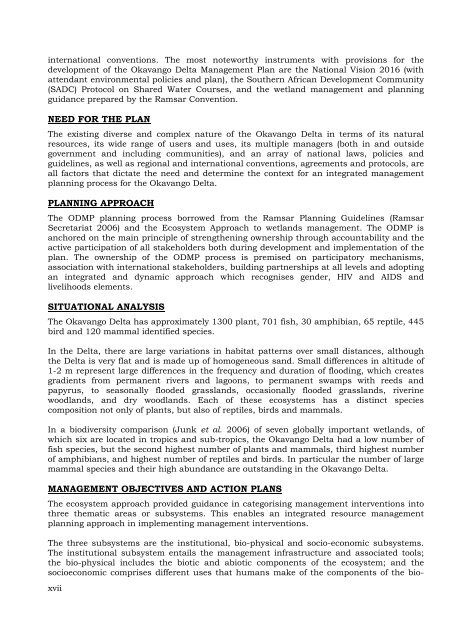Okavango Delta Management Plan - Ramsar Convention on Wetlands
Okavango Delta Management Plan - Ramsar Convention on Wetlands
Okavango Delta Management Plan - Ramsar Convention on Wetlands
You also want an ePaper? Increase the reach of your titles
YUMPU automatically turns print PDFs into web optimized ePapers that Google loves.
internati<strong>on</strong>al c<strong>on</strong>venti<strong>on</strong>s. The most noteworthy instruments with provisi<strong>on</strong>s for the<br />
development of the <str<strong>on</strong>g>Okavango</str<strong>on</strong>g> <str<strong>on</strong>g>Delta</str<strong>on</strong>g> <str<strong>on</strong>g>Management</str<strong>on</strong>g> <str<strong>on</strong>g>Plan</str<strong>on</strong>g> are the Nati<strong>on</strong>al Visi<strong>on</strong> 2016 (with<br />
attendant envir<strong>on</strong>mental policies and plan), the Southern African Development Community<br />
(SADC) Protocol <strong>on</strong> Shared Water Courses, and the wetland management and planning<br />
guidance prepared by the <str<strong>on</strong>g>Ramsar</str<strong>on</strong>g> <str<strong>on</strong>g>C<strong>on</strong>venti<strong>on</strong></str<strong>on</strong>g>.<br />
NEED FOR THE PLAN<br />
The existing diverse and complex nature of the <str<strong>on</strong>g>Okavango</str<strong>on</strong>g> <str<strong>on</strong>g>Delta</str<strong>on</strong>g> in terms of its natural<br />
resources, its wide range of users and uses, its multiple managers (both in and outside<br />
government and including communities), and an array of nati<strong>on</strong>al laws, policies and<br />
guidelines, as well as regi<strong>on</strong>al and internati<strong>on</strong>al c<strong>on</strong>venti<strong>on</strong>s, agreements and protocols, are<br />
all factors that dictate the need and determine the c<strong>on</strong>text for an integrated management<br />
planning process for the <str<strong>on</strong>g>Okavango</str<strong>on</strong>g> <str<strong>on</strong>g>Delta</str<strong>on</strong>g>.<br />
PLANNING APPROACH<br />
The ODMP planning process borrowed from the <str<strong>on</strong>g>Ramsar</str<strong>on</strong>g> <str<strong>on</strong>g>Plan</str<strong>on</strong>g>ning Guidelines (<str<strong>on</strong>g>Ramsar</str<strong>on</strong>g><br />
Secretariat 2006) and the Ecosystem Approach to wetlands management. The ODMP is<br />
anchored <strong>on</strong> the main principle of strengthening ownership through accountability and the<br />
active participati<strong>on</strong> of all stakeholders both during development and implementati<strong>on</strong> of the<br />
plan. The ownership of the ODMP process is premised <strong>on</strong> participatory mechanisms,<br />
associati<strong>on</strong> with internati<strong>on</strong>al stakeholders, building partnerships at all levels and adopting<br />
an integrated and dynamic approach which recognises gender, HIV and AIDS and<br />
livelihoods elements.<br />
SITUATIONAL ANALYSIS<br />
The <str<strong>on</strong>g>Okavango</str<strong>on</strong>g> <str<strong>on</strong>g>Delta</str<strong>on</strong>g> has approximately 1300 plant, 701 fish, 30 amphibian, 65 reptile, 445<br />
bird and 120 mammal identified species.<br />
In the <str<strong>on</strong>g>Delta</str<strong>on</strong>g>, there are large variati<strong>on</strong>s in habitat patterns over small distances, although<br />
the <str<strong>on</strong>g>Delta</str<strong>on</strong>g> is very flat and is made up of homogeneous sand. Small differences in altitude of<br />
1-2 m represent large differences in the frequency and durati<strong>on</strong> of flooding, which creates<br />
gradients from permanent rivers and lago<strong>on</strong>s, to permanent swamps with reeds and<br />
papyrus, to seas<strong>on</strong>ally flooded grasslands, occasi<strong>on</strong>ally flooded grasslands, riverine<br />
woodlands, and dry woodlands. Each of these ecosystems has a distinct species<br />
compositi<strong>on</strong> not <strong>on</strong>ly of plants, but also of reptiles, birds and mammals.<br />
In a biodiversity comparis<strong>on</strong> (Junk et al. 2006) of seven globally important wetlands, of<br />
which six are located in tropics and sub-tropics, the <str<strong>on</strong>g>Okavango</str<strong>on</strong>g> <str<strong>on</strong>g>Delta</str<strong>on</strong>g> had a low number of<br />
fish species, but the sec<strong>on</strong>d highest number of plants and mammals, third highest number<br />
of amphibians, and highest number of reptiles and birds. In particular the number of large<br />
mammal species and their high abundance are outstanding in the <str<strong>on</strong>g>Okavango</str<strong>on</strong>g> <str<strong>on</strong>g>Delta</str<strong>on</strong>g>.<br />
MANAGEMENT OBJECTIVES AND ACTION PLANS<br />
The ecosystem approach provided guidance in categorising management interventi<strong>on</strong>s into<br />
three thematic areas or subsystems. This enables an integrated resource management<br />
planning approach in implementing management interventi<strong>on</strong>s.<br />
The three subsystems are the instituti<strong>on</strong>al, bio-physical and socio-ec<strong>on</strong>omic subsystems.<br />
The instituti<strong>on</strong>al subsystem entails the management infrastructure and associated tools;<br />
the bio-physical includes the biotic and abiotic comp<strong>on</strong>ents of the ecosystem; and the<br />
socioec<strong>on</strong>omic comprises different uses that humans make of the comp<strong>on</strong>ents of the bio-<br />
xvii

















